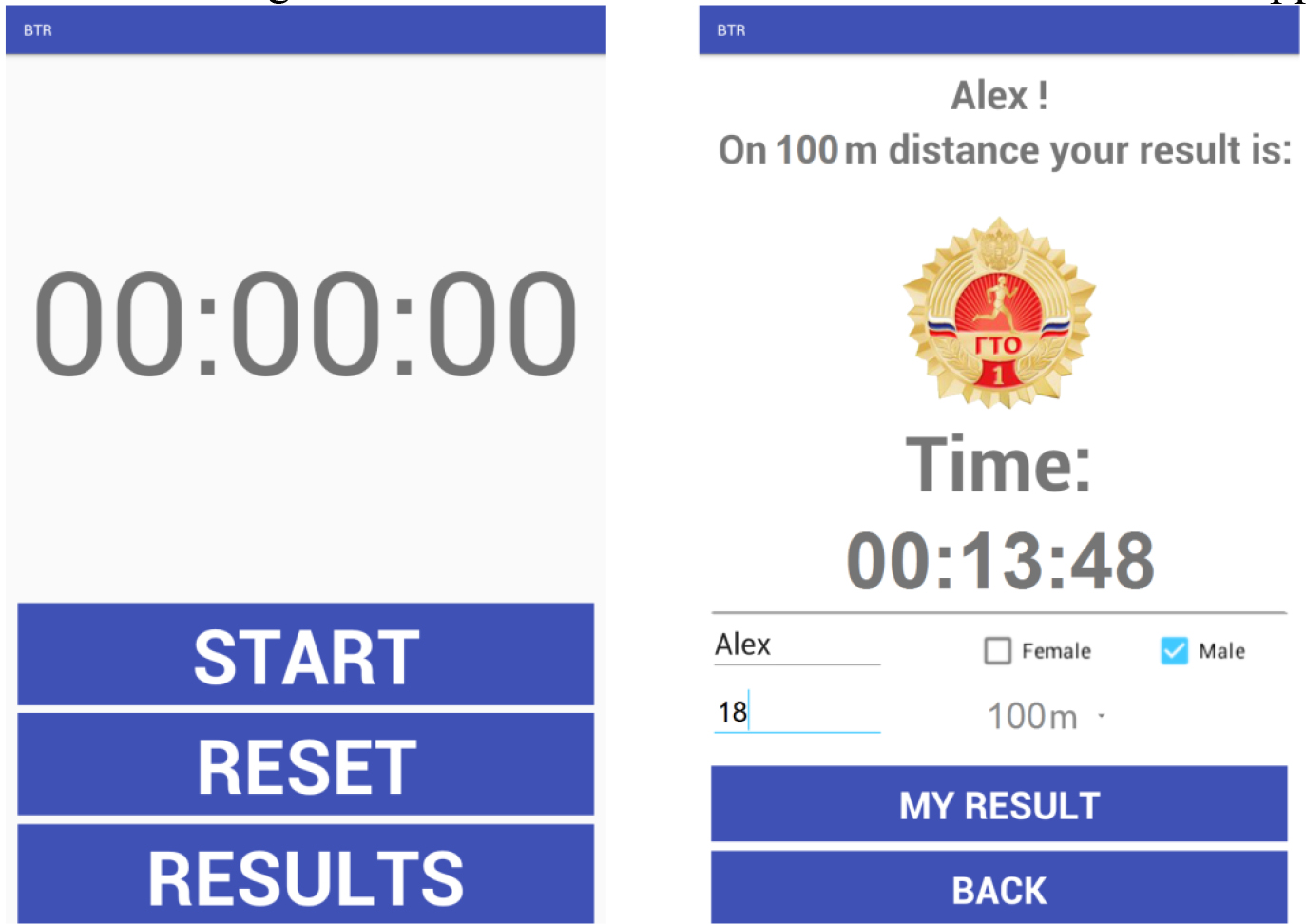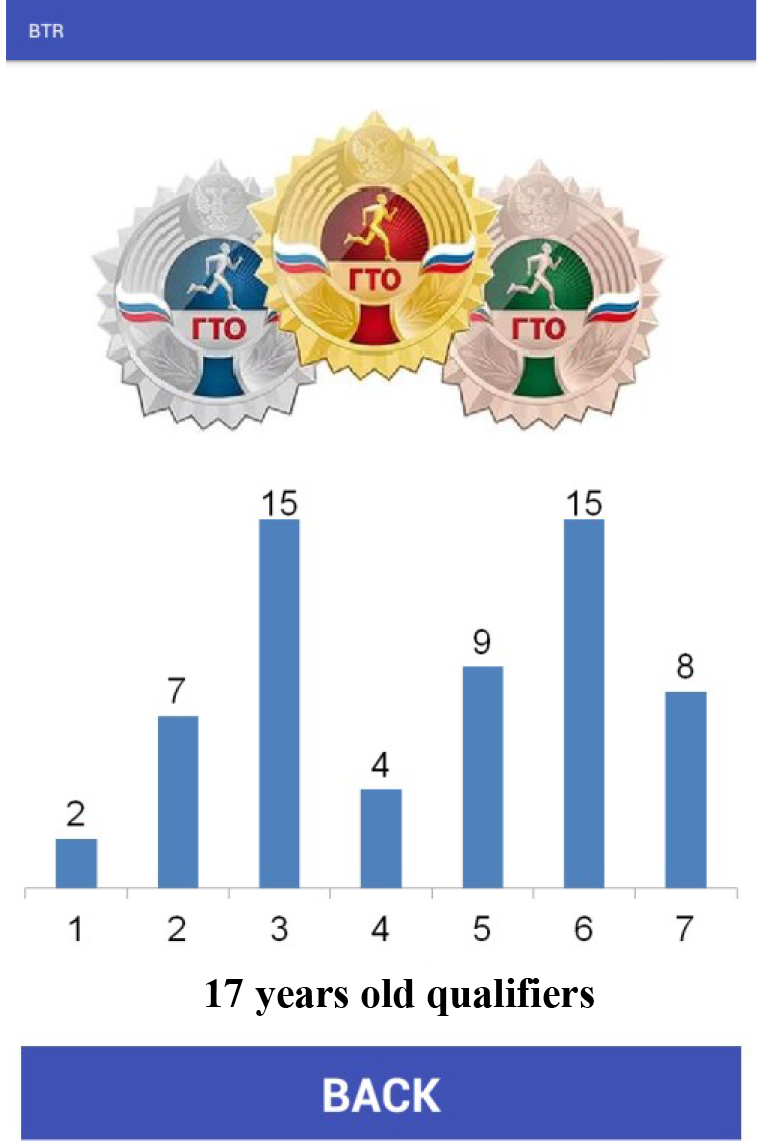Mobile devices and software applicable in Russian physical culture and sports GTO complex tests
Фотографии:
ˑ:
PhD, Associate Professor A.V. Minkin1
PhD, Associate Professor А.V. Kostin1
PhD, Associate Professor N.N. Kostina1
1Elabuga Institute of Kazan (Volga region) Federal University, Elabuga
Keywords: sports standards, GTO, mobile systems, physical education.
Background. The President and Government of the Russian Federation supported the efforts to develop an updated version of the Russian Physical Culture and Sports “Ready for Labour and Defence” (GTO) Complex tests for 11 age groups [3]. Presently the GTO Complex is considered a regulatory and programmatic basis for the national physical education system [1]. To contribute to the GTO Complex promotional and popularisation initiatives, we have developed a mobile unit with application software that, as we expect, will facilitate the GTO Complex reinstatement project by effectively luring the most active users of mobile devices and social systems [10]. The mobile application offers a range of services including: registration for the tests; photo- and video-file sharing service; test date, time and place reminding to the user etc. The services are provided to the authorised users with an access to their personal accounts where they can get their unique identification codes (UIC) and current information on the tests, qualifications for the badges and test certificates. Non-authorised users may still have from the mobile GTO Complex application background information on the GTO Complex test standards and the regional GTO test centres available for them in 85 regions of the Russian Federation. Furthermore, the mobile GTO Complex application offers special services for the GTO test centre administrators and referees. Thus the mobile application provides tools to register qualifiers for the GTO tests and form online-protocols of the tests. The referees may read the unique identification numbers (UIN formed by QR-codes based technology) of the qualifiers and keep the test records on a real-time basis with the test results being fixed in the electronic test records and personal accounts of the qualifiers. However, the mobile application still provides no means at this juncture to comprehensively analyse the GTO test data for a specific group of qualifiers (e.g. schoolchildren or students) although such service could contribute, in our opinion, to the GTO Complex test processing capacity.
It should be noted that one can find quite many mobile gadgets and systems applicable for the GTO Complex test processing purposes including, for instance, push-ups registration device [8], high bar pull-ups registration unit [7], jump data reading system [9] etc. Most of the systems, however, are outdated, and their mobile versions[1] are not always mobile enough in fact under the modern standards and/or require special installation and operation services.
Objective of the study was to rate benefits of a mobile unit (designed by one of the authors) for GTO Complex test data registration and offer a mobile application version for the GTO test data processing.
Methods and structure of the study. It is not unusual for any physical education teacher to face the situations when he/she needs a reliable physical fitness and qualification data for a new group of trainees to prudently design and manage their training loads on an individual basis. Normally a school/ university physical education teacher acts in such case as follows [5]:
1) Gets access to the trainees’ databases to get data on their track records and physical fitness rates;
2) Analyses the data and individual records to design and manage the group/ individual physical progress paths; and
3) Controls the trainees’ performance and actual physical progress in the training process to assess the effectiveness of the group/ individual educational models and improve the fitness rates.
However, as provided by studies [4, 5, 6], the individual physical progress data are traditionally recorded manually in the students’ progress registration logbooks that actually provide little if any data on the individual lags in the physical qualities of the trainees. Moreover, normally all the individual physical fitness data are still memorised by the physical education teacher and, hence, nobody else may take grounded decisions on the group/ individual physical progress design and management process. This problem was addressed by the authors of the above-mentioned studies who propose the online services provided by the automated GTO Complex Service System as a solution. However, this system can hardly be named mobile since the test data are normally input to the system manually rather than via individual test data registration units. This was the reason for us to consider and offer a new mobile unit for automated registration of the standard GTO 100m sprint tests passed by schoolchildren and university students.
To secure high accuracy of the GTO sprint test data, we developed the mobile unit with software including the following subunits: finishing photo-optic system fixing the laser beam blocking moment; Bluetooth technology based receiving and transmitting unit; signal processing system based on an AVR microcontroller; and an Android-based mobile application for the GTO test data reading and processing on a real-time basis. The software for the mobile unit was designed using the standard Android Studio toolkit. Given on Figure 1 hereunder is the interface of the new mobile application software.

Figure 1. Screenshots of the application interface
The study was designed and performed at Elabuga Institute (affiliate) of Kazan Federal University in October 2016. Subject to the study were two groups of 60 people each who tried to pass the GTO 100m sprint test.
Study results and discussion. Group one was composed of 60 male students of 18 years of age. The mobile unit fixed the following test results: 9 (15%) of the subjects qualified for the Cold GTO Badge; 28 (46.7%) for the Silver GTO Badge; 7 (11.7%) for the Bronze GTO Badge; and 16 (26.6 %) failed the tests.
Let us apply an express-method to obtain the subjects’ physical fitness rates. The data array of the GTO 100m sprint test results was grouped into 7 groups at equal intervals using the popular Sturge's Formula to compute the group rates. Given on Figure 2 hereunder is the resultant frequency histogram.

Figure 2. Students’ group frequency histogram
The data processing resulted in a specific distribution (Figure 2) that gives the grounds to profile, at a first approximation, the subjects’ fitness rates. The number of modes and their values show that we have a unimodal distribution close to normal with a=14.7 and σ=1.19 albeit somewhat asymmetrical (with the median value shifted to the left from the mean one). A physical education teacher of this students’ group may not go into every detail of the data array for the 18 years old subjects knowing the general characteristics of the subject group, and the statistical correlations criteria are also unlikely informative enough for his practical purposes.
For the comparative purposes, we tested the mobile unit on Group 2 of 60 senior schoolchildren of 17 years of age from Elabuga city. The data array showed a different (bimodal) distribution as demonstrated on Figure 3 hereunder. The data analysis gives the grounds to identify a physically fit and well-trained in the 100m sprint subgroup of people in the sample; and the other considerable subgroup poorly fit for this GTO test. It is normal for any test to generate the worst and best results, but a wide dispersion of the modes in this case shows that about half of the tested subjects are fairly fit for the test discipline and the others are unfit in fact.

Figure 3. Schoolchildren’s group frequency histogram
The physical fitness rating test data for the students’ and schoolchildren groups give the grounds to design a set of special physical practices to ensure progress of the subjects on the whole and in the GTO sprint discipline in particular. Information on the reasons for the poor test rates, the relevant factors of influence and the recommended corrective actions may be found, for example, in study [5].
Conclusion. The study data and analyses demonstrate benefits of the newly designed mobile unit and application software for the GTO Complex test data recording and processing as it helps the qualifiers and physical education teachers obtain a real-time data on the test process and results; and the educator may make due adjustments to the physical progress paths of the trainees to make them fit for the GTO Complex tests. Due consideration should be also made for the qualifiers’ motivations that may facilitate their success in the tests [2].
References
- Lubysheva L.I. Vserossiyskiy kompleks GTO kak faktor razvitiya fizkulturno-sportivnoy deyatelnosti vuza [All-Russian GTO complex as a factor in development of academic physical education and sports activities]. Sb. nauch.-prakt. konf. «Fizicheskaya kultura, sport, turizm: nauchno-metodicheskoe soprovozhdenie» [Proc. res.-practical conf. "Physical culture, sports, tourism: scientific and methodological support" (May 15 - 16, 2014)]. PSHPU, Perm, 2014, pp. 184 – 189.
- Popova A.O., Ivanova L.A., Savelyeva O.V. Motivatsiya studentov – effektivny sposob vypolneniya normativov kompleksa GTO [Motivation of students to meet GTO complex requirements]. Naukovedenie, 2015, no. 3 (7); Available at: http://naukovedenie.ru/PDF/19PVN315.pdf.
- Postanovlenie Pravitelstva RF ot 11 iyunya 2014 g. no. 540 «Ob utverzhdenii Polozheniya o Vserossiyskom fizkulturno-sportivnom komplekse “Gotov k trudu i oborone” (GTO)» [RF Government Decree dated June 11, 2014 no. 540 "On the approval of the Regulations on the All-Russian Physical Culture and Sports GTO Complex "Ready for Labor and Defense"]. Available at: http: //www.minsport.gov.ru/post540_11062014.pdf.
- Sinyavskiy N.I., Fursov A.V., Ivanov K., Fokina O.S. On-line-tekhnologii v sisteme podgotovki shkolnikov k vypolneniyu normativov Kompleksa «Gotov k trudu i oborone [On-line-technologies in training of pupils for "Ready for Labour and Defence" tests]. Fizicheskaya kultura: vospitanie, obrazovanie, trenirovka, 2015, no. 6, pp. 49 – 52.
- Sinyavskiy N.I., Fursov A.V., Ignatov O.V., Ivanov K.G. Primenenie onlayn-servisa v korrektsii otkloneniy fizicheskoy podgotovlennosti shkolnikov k vypolneniyu normativov VFSK GTO [Application of online service to correct deviations in physical fitness of schoolchildren for implementation of RPCSC GTO standards]. Uchenye zapiski un-ta im. P.F. Lesgafta, 2015, no. 12 (130), pp. 197–200.
- Sinyavskiy N.I., Fursov A.V., Kamartdinova A.A., Gerega N.N. Primenenie onlayn tekhnologiy v programmno-metodicheskom obespechenii Vserossiyskogo fizkulturno-sportivnogo kompleksa «Gotov k trudu i oborone» (GTO) [Application of online technologies in software and methodological support of Russian physical culture and sports "Ready for labour and defence" GTO complex]. Uchenye zapiski un-ta im. P.F. Lesgafta, 2015, no. 3 (123), pp.133–136.
- Sposob izmereniya vynoslivosti pri podtyagivaniyakh tela v naklone: svidetelstvo no. 238260 Ros. Federatsiya. no. 2008111301/14; zayavl. 24.03.2008; opubl. 27.02.2010 [Endurance measurement method during bent over pull-ups: certif. no. 238260 RF. No. 2008111301/14; appl. 24.03.2008; publ. 27.02.2010] Bul. no. 6, 1 p.
- Ustroystvo dlya kontrolya otzhimaniy ot pola: svidetelstvo no. 59983 Ros. Federatsiya. no. 2006115968/22; zayavl. 10.05.2006; opubl. 10.01.2007 [Push-ups control device: certificate no. 59983 ROPP. RF. No. 2006115968/22; appl. 10.05.2006; publ. 10.01.2007], Bul. no. 1, 1 p.
- Ustroystvo I.V. Meskina dlya opredeleniya dliny pryzhka: svidetelstvo no. 1591233 SSSR. no. 4230845/12; zayavl. 16.04.1987; opubl. 20.11.1996 [Meskin's jump length measurement device: certificate no. / The USSR. No. 4230845/12; appl. 16.04.1987; publ. 11/20/1996]. Bul. no. 32, 2 p.
- Sherin V.S., Zamyatin A.V., Sherina E.A., Kolyaskina T.Y. Mobilnoe prilozhenie kak faktor effektivnoy podgotovki cheloveka k vyipolneniyu normativov Kompleksa GTO [Mobile application tool to facilitate training for GTO Complex tests]. Teoriya i praktika fiz. kultury, 2017, no. 4, pp. 89–90.
Corresponding author: avminkin@yandex.ru
Abstract
The authors developed a mobile unit with application software to record and process the GTO Complex 100m sprint test data. The mobile unit was tested at Elabuga Institute of Kazan Federal University to obtain and analyse the GTO Complex test data. The overall physical fitness rates of the students were tested by the statistical express test method, and the group test data showed a unimodal distribution close to normal. Comparative tests of the schoolchildren’s group of inconsistent composition yielded a bimodal distribution of the test data. We believe that the new mobile unit with the application software could be beneficial for the physical education process for the reason that the system is effective in GTO test data real-time recording and processing and allows the physical progress paths being corrected on a timely basis.



